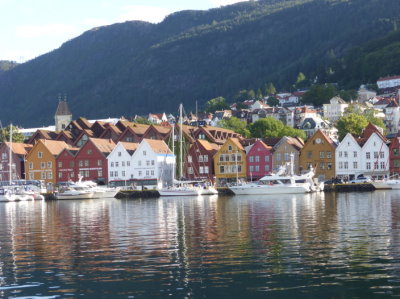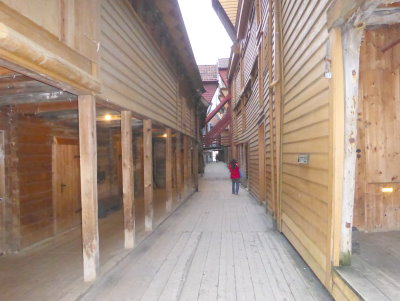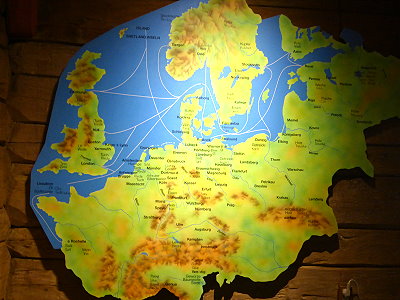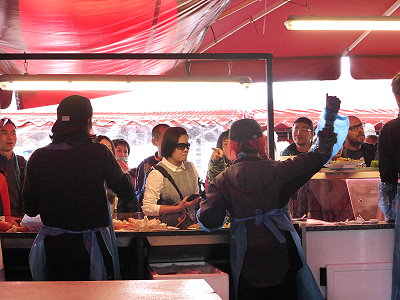Bryggen is a historic harbour district in Bergen, one of North Europe’s oldest port cities on the west coast of Norway, which was established as a centre for trade by the 12th century. In 1350 the Hanseatic League established a “Hanseatic Office” in Bergen. They gradually acquired ownership of Bryggen and controlled the trade in stockfish mostly from the Lofoten in Northern Norway through privileges granted by the Crown. The Hanseatic League established a total of four overseas Hanseatic Offices, Bryggen being the only one preserved today.

The UNESCO World Heritage site is, of course, not a conventional « exhibition », but rather a lively and by now very touristy place during summer, where visitors get a feel for life and culture of days past blended with present-day food and drinks. For centuries it was the priviledged trading place where stockfish (dried cod), cod liver oil, hides, furs, butter and tallow from the North was exchanged against flour, grain, malt, salt, beer, hop, hemp, fabrics, hardware and glass.
The Bergen office was governed by rules set at the Hansa Day or general assembly of each town and its traders combining their efforts for greater negotiation capacity. Office members were expected to follow these rules overseen by the town council in Lübeck on the Baltic Sea. In addition, each Office had its own rules.
The Hanseatic merchants were subject to these rules in the only area, where they were allowed to settle: Bryggen, along the wharf on the east side of the harbour. There, behind the waterfront houses, up to more than 10 further trading houses could be constructed in long rows, one attached to the other, each with their manager, journeyman and apprentices, a large, entirely male population. Outside of densely populated Bryggen, the Hanseatic traders were subject to Norvegian law. They were allowed to sell and buy freely in Norvegian towns and markets, but not to travel further north than Bergen.

Among the priviledges granted to the Hanseatic merchants was a comparatively low duty of 148 kilos of grain for each ship that arrived in Norvegian towns or markets and the rescue their own goods when ship-wrecked while asking for help. So instead of coastal communities having full salvage rights, they were only paid up to 10% of the cargo’s value.
The exchange of goods was predominantly by barter. Very little money changed hands. In years of bad catches, the merchant would give their customers sufficient supplies to manage through hard times. This credit « was called Northern Norway traders’ debt, and it eventually grew to a substantial amount. It was free of interest until the middle of the 19th century. The benefit for the merchant was the obligation of the debtor to deliver his good exclusively to the creditor. Such debt could pass on as an inheritance without being paid off, thus several families were customers in the same house for generations. »
The fishers in Northern Norway produced two types of stockfish: whole fish and cut fish. The whole fish was gutted and dried in one piece, while the cut fish was split along the spine all the way to the tail and dried in the particularly favourable conditions there. « The German merchants on Bryggen sorted the fish into several categories. In the 18th century there were 23 different qualities of cod, six qualities of bream and two qualities of pollack. Each had its specific market and price. So sorting was a highly skilled work demanding a thorough knowledge of the fish as well as the markets. »

Cod liver oil was divided into three different qualities starting in the 18th century: clear cod liver oil was the first fluid that floated at the surface of barrelled liver; brownish cod liver oil was obtained by boiling the liver after extracting the clear oil in the first step; after further boiling brown oil was obtained for use in lamps.
At the height of the stockfish trade, some 100 transport boats hauled the product to Bergen and was there distributed to all trading houses. There were two peak seasons during the year, in May and August-September. Large quantities of merchandise from the North was then to be unloaded in a short period of time and similar quantities of flour and other products uploaded to make the return trip. As the point of first call was the captain’s merchant, some got too much and others too little.

At the end of the unloading a commission was appointed to prepare a balance account for equitable sharing. The merchants settled the accounts among themselves with cash, not barter. « Book keeping was done in a particular manner. Firstly, the journeyman drew up a draft of the trade with Northern Norway, in which all incoming and outgoing goods per customer were recorded. Then this draft was turned over to the trade manager, who entered the principal amounts into the main ledger. »
This ledger reflected the losses and gains, the size of the trading debt of Northern Norway and the number of regular customers and expected deliveries. As a result, the main ledger, which belonged to the house and not the individual merchant, allowed to estimate the value of a trading house in case of sale.
The decline of the Hanseatic League began with the age of European discoveries of sea routes to other continents. With some delay, between 1630 and 1700 the cohesion of merchants in the Bryggen office also weakened and trading houses were sold to Norvegian traders not bound by the Hanseatic disciplines. In 1701, just before the great fire of 1702 that destroyed 80% of the wodden houses, there were still 47 Hanseatic houses vs 31 Bergen-owned houses.

But by 1740 only 9 German trading houses were left and their administration of Bryggen had become untenable. In 1764, the Norwegian Office was founded in replacement of the German Office marking the end of four centuries of Hanseatic dominance of the trade in Bryggen.
The new Office drew its members from Bergen, but many of these were still German and the old system continued with few changes as many Hanseatic rules were kept in place. German remained even the language for many a barter trade. It closed down eventually in 1899 bringing to an end a long historical relationship.
The Hanseatic Museum in Bryggen is accommodated in the waterfront house of the Finnegården tenement. The other tenements are close by, all only separated by narrow pathways, which made fire a major risk, particularly in the old days (see second photo above). At the time it was therefore forbidden to light a fire for heating or illumination. Still, fires occurred from time to time and each house was equipped with axes, buckets and other firefighting utensils.

The museum house is well kept and shows utensils, showroom, store rooms, office space and mostly spartanic living quarters of the all male trading houses. It gives an impression of living conditions of the inhabitants. The historical records show that luxury was frowned upon and even triggered penalties.
They were usually composed of several apprentices of 14 to 15 years of age, who had to serve for six years before sitting an exam in their trade. If they passed they could become journeymen. As journeymen, they were the second in charge of the house and even become manager, when the holder of the position returned to Germany.

Owners or principals rarely lived in Bryggen directing their business rather from their home base. The manager supervised the business on behalf of the principal.
After some years he would buy his own trading house and move back to Germany becoming a principal himself. Alternatively, he would open a business back home instead of buying a trading house in Bryggen.
Today, the fish market at the end of the wharf is very touristy during the short summer period and Asian and southern nationalities are found on both sides of the counter, as vendors and buyers.
Cod, farmed salmon and a variety of northern seafood are the mainstay. Most stands are equipped to turn the seafood bought into a delicious meal to be consumed on the spot.

Sadly, several stands also proposed whale meat since Norway has joined the small group of fishing nations insisting on reviving the practice. Most countries and even young people in whaling nations for the most part don’t want to eat it anymore. So, much of it ends up in pet food. Luckily, Norway’s fisheries and cooperation policies has more positive sides to its credit and delving into Bergen’s rich past and interesting present is definitely worth exploring further.
The quotations are from the museum guide «The Hanseatic Museum and Schøtstuene» by Marco Trebbi (1996). A more extensive and beautifully illustrated book about the place is «Bryggen. The Heart of Bergen», by Marco Trebbi with photos by Jiri Havran, published by ARFO, Oslo in 2007.
Text and photos of this short review are by Cornelia E Nauen as part of the participation in the EADI Nordic 2017 Conference in Bergen, 20 to 23 August 2017.
